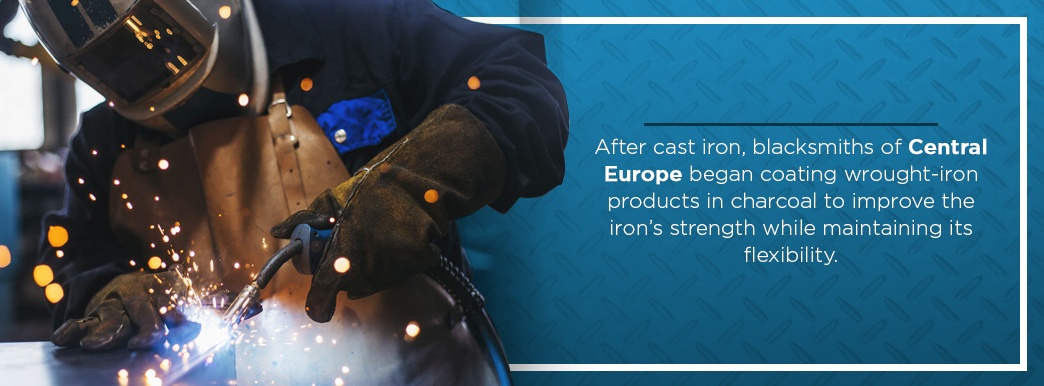
This might not seem like a commodity associated with advanced technology, but steel manufacturing has come a long way. In this guide to the steel manufacturing process, we’ll explore the history of steel and compare it to how steel is made and used in modern applications.
Steel is a discovery of the Iron Age, a period that started around 1200 BCE. Iron ore was first mined in Central Asia and Europe, and humans at this time used iron to make tools and weapons in a practice called ferrous metallurgy. Iron products evolved during this time, beginning with blacksmiths producing wrought iron goods. These tradespeople learned to heat up iron ore, and using a hammer-and-anvil process, the blacksmiths would remove impurities from the metal and produce a durable and malleable final iron product.
Iron took a few other forms before eventually arriving at what is today considered steel. In China, Iron Age metallurgists heated up iron in large furnaces, effectively melting the substance into liquid and mixing it with the wood fuel. The melted liquid would then be poured into molds, which would then be left to harden, eventually taking the shape of cooking tools and other objects from the molds. This process, known as cast iron, produced a more durable product than wrought iron, but it was brittle, making it difficult to shape and bend.

After the discovery of iron-carbon alloys, various civilizations began to scale up their steel-production practices, allowing them to make improved weapons, tools and structures. Since the Iron Age, humans have looked to perfect the steel manufacturing process, not only to produce it in greater quantities but to produce it more effectively. The continuous improvement of steel production is the reason why steel today has become such a crucial global commodity.
The modern-day steel production process began in 1856 under a process known as the Bessemer process. It’s largely considered to be the first process used to mass-produce steel. According to historians, two different inventors, one in the UK and one in Pittsburgh, both simultaneously developed a steel production process that involved removing iron’s impurities through the use of an air blast.
With this discovery, other steel producers began to perfect the process, eventually discovering a way to use the air-blasting technique to help preserve the carbon content while fully eliminating impurities. Finally, the process evolved into a highly cost-effective way of mass-producing high-quality steel that we still use today.
Today, the manufacturing of steel is done by using one of these two methods:
The EAF method is the most common steel making process today. Today’s modern EAF steelmaking furnaces produce 150 tons of steel per melt, which takes approximately 90 minutes.
Steel is a versatile, affordable and abundant material, making it the perfect substance to use in countless manufacturing capacities. Original equipment manufacturers and other fabrication companies rely on the value of steel to produce their original components and products.
All around the world, businesses source steel and metals-alloys to build their products and bring their designs to life. Custom metal manufacturing and design is a critical professional service in the global economy because it’s what allows businesses to invent new and useful goods and take risks on innovative designs that help shape and improve our daily lives.
Metal manufacturing and design brings together a range of experts, from designers, engineers and consultants to welders, metalworkers and installers. Every expert has a role to play in ensuring that steel and metal materials get turned into well-designed, high-quality components and end-products that go on to serve an important role in our global marketplace.
Manufacturers and OEM businesses require reliable, professional and knowledgeable metal contract manufacturing partners to help them produce steel and metal finished products efficiently and at the highest standards possible. If you’re looking for a precision metal manufacturing company to meet your unique business needs, choose Summit Steel.
For over 25 years, Summit Steel has been helping businesses efficiently produce parts through cutting-edge production and manufacturing processes. Our contract metal manufacturing services range from initial design and engineering support to laser-cutting, 3D machining and steel and metal welding processes. Our flexible service offerings can be tailored to meet whatever volume of production your business needs. From single-source capabilities to high-volume orders, Summit Steel can deliver high-quality, precision-manufactured metal and steel products and parts for your industry.
For more information on contracting with Summit Steel for custom metal manufacturing, contact us today. Call us at 610-921-1119 or request a quote online.